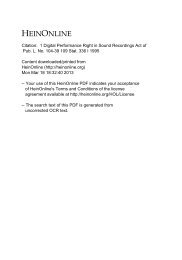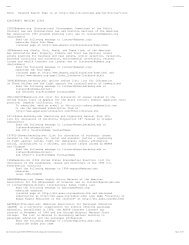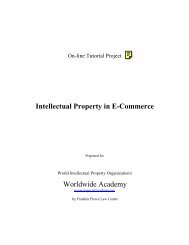BIEDERMANN MOTECH GMBH and Depuy Spine, Inc, Plaintiffs
BIEDERMANN MOTECH GMBH and Depuy Spine, Inc, Plaintiffs
BIEDERMANN MOTECH GMBH and Depuy Spine, Inc, Plaintiffs
Create successful ePaper yourself
Turn your PDF publications into a flip-book with our unique Google optimized e-Paper software.
amenable to summary judgment." Laitram Corp. v. Morehouse Indus., 143 F.3d 1456, 1462 (Fed.Cir.1998).<br />
However, this Court notes in passing that several traditional features of summary judgment are not invoked<br />
in a claim construction motion. Summary judgment is a mechanism provided for in Rule 56(c) of the<br />
Federal Rules of Civil Procedure to resolve claims if there is no genuine issue as to any material fact, after<br />
considering the pleadings <strong>and</strong> any depositions, answers to interrogatories, admissions, or affidavits. The<br />
Supreme Court explained various rules for resolving alleged factual disputes in a trio of cases decided two<br />
decades ago, Anderson v. Liberty Lobby, <strong>Inc</strong>., 477 U.S. 242, 106 S.Ct. 2505, 91 L.Ed.2d 202 (1986),<br />
Matsushita Elec. Indus. Co. v. Zenith Radio, 475 U.S. 574, 106 S.Ct. 1348, 89 L.Ed.2d 538 (1986), <strong>and</strong><br />
Celotex Corp. v. Catrett, 477 U.S. 317, 106 S.Ct. 2548, 91 L.Ed.2d 265 (1986). The rules include such<br />
familiar principles as the one that inferences from the underlying facts must be viewed in light most<br />
favorable to the non-moving party. Matsushita, 475 U.S. at 587.<br />
However, the Federal Circuit has held that claim construction is a purely legal determination. According to<br />
the Federal Circuit, extrinsic evidence is only used for the Court's underst<strong>and</strong>ing of the patent. Cybor Corp.<br />
v. FAS Techs., 138 F.3d 1448, 1455 (Fed.Cir.1998) (en banc). When the Court construes the true meaning<br />
of the claims with the aid of extrinsic evidence, according to the Federal Circuit, the Court is not making<br />
factual findings or crediting certain evidence over other evidence. Id. According to the Federal Circuit, while<br />
"the trial judge may seek underst<strong>and</strong>ing outside the patent proper, from relevant texts <strong>and</strong> materials, <strong>and</strong><br />
from experts in the art," "none of this involves 'fact-finding' in the sense of the traditional fact-law<br />
dichotomy." Id. at 1462.<br />
Therefore, this Court does not favor the evidence or argument of the moving <strong>and</strong> nonmoving parties<br />
differently, as it would in a typical motion for summary judgment.<br />
B. Claim Construction<br />
Before a jury can determine if the <strong>Plaintiffs</strong>' patents are invalid or if the Defendants' technology infringes<br />
<strong>Plaintiffs</strong>' patents, the Court must determine the meaning <strong>and</strong> scope of the patent claims at suit through<br />
"claim construction." Markman v. Westview Instruments, <strong>Inc</strong>., 52 F.3d 967, 976 (Fed.Cir.1995) (en banc),<br />
aff'd, 517 U.S. 370, 116 S.Ct. 1384, 134 L.Ed.2d 577 (1996). Only after claim construction can the jury<br />
compare the allegedly infringing device against the claims. Id.<br />
The Federal Circuit's definitive statement of its claim construction jurisprudence is contained in an en banc<br />
case titled Phillips v. AWH Corp., 415 F.3d 1303, 1311-24 (Fed.Cir.2005) (en banc). The general rule is that<br />
the claims are of primary importance in ascertaining exactly what has been patented. Elements which are<br />
not actually in the claim should not be added to the claim through interpretation. Id. at 1312. The words in a<br />
claim are to be given their "ordinary <strong>and</strong> customary meaning." Id . The "ordinary <strong>and</strong> customary meaning"<br />
is the one which a person of ordinary skill in the art would have understood the words to mean at the time<br />
the patent application was filed. Id. at 1312-13. The parties did not stipulate as to the ordinary level of skill<br />
relevant to this case, however, they do not argue that the appropriate claim construction depends on ordinary<br />
level of skill in the art.<br />
A person of ordinary skill in the art could have had a well-established notion of what various words meant<br />
before reading the patent application. However, the words may have had more specific or slightly different<br />
meanings in the context of the patent application. The person of ordinary skill interpreting the patent claims<br />
is assumed to have read the entire patent specification along with the patent claims. Id. Thus, the patent<br />
specification is the "primary basis" for the Court to construe the claims, id. at 1315, <strong>and</strong> it is entirely






